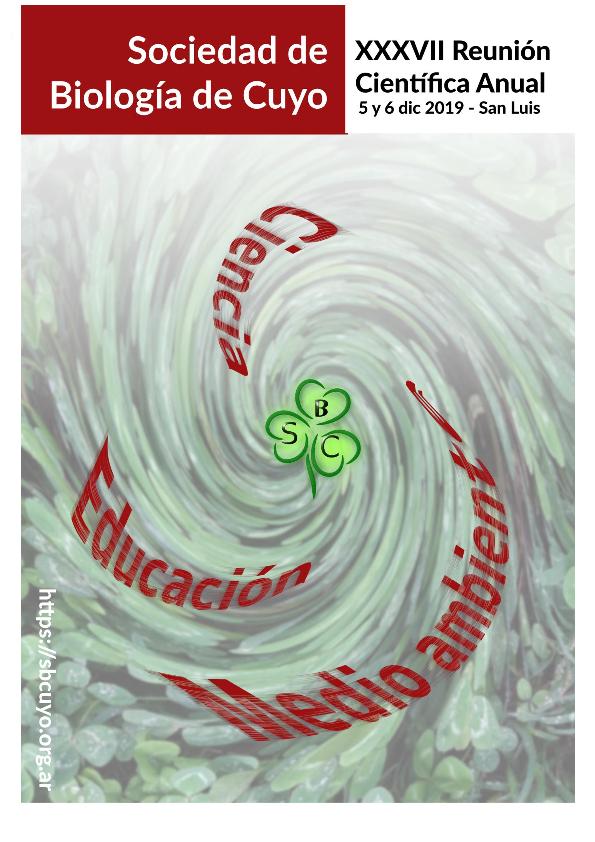Mostrar el registro sencillo del ítem
dc.contributor.author
Parera, Victoria

dc.contributor.author
Feresin, Gabriela Egly

dc.contributor.author
Parera, Carlos

dc.date.available
2022-07-04T16:02:06Z
dc.date.issued
2019
dc.identifier.citation
Effect of heavy metals on seed germination of Adesmia subterranea and Adesmia pinnifolia: Implications for phytoremediation; XXXVII Reunión Anual de La Sociedad de Biología de Cuyo; San Luis; Argentina; 2019; 97-97
dc.identifier.uri
http://hdl.handle.net/11336/161180
dc.description.abstract
Phytoremediation is the use of plants to reduce the concentrations or toxic effects of contaminants in the environments and it´s considered an efficient, ecological and low-cost solution to the problem of heavy metal pollution. A great number of members of Fabaceae are well known to have the capacity to accumulate and tolerate heavy metal. Germination and root elongation are two critical stages in plant development that are sensitive to environmental contaminants. The aim was to determine the effect of different concentrations of Cadmium (Cd) and Nickel (Ni) on seed germination, emergence rate index (ERI) and % phytotoxicity (%P) on A. subterranea and A. pinnifolia. Seeds were treated with three levels of Cd: 500µM; 1000µM and 2000µM and Ni: 100µM; 200µM; 400µM and a control treatment (distilled water). Four replicates (25 seeds) per level of treatment and species were tested in a germination chamber. Agar media was used as germination substrate. The germinated seeds was recorded every 24h for one week. A seed was considered germinated when the emerging radicle was longer than 1 mm. The root length was measured after 10 days. Generalized linear mixed-effects models with a binomial error distribution was used for germination, and ANOVA followed by LSD Fisher for ERI and % phytoxicity. Results showed that the effect of the treatments on germination and ERI depend on the specie (treatments*specie p=0, 0001). The number of germinated seeds was significantly higher in treatments with Ni and control compared with Cd for both species. Cd 2000 µM reduced significantly the germination to 2 seeds for A. pinnifolia and 56 seeds for A.subterranea. Similar results were observed in the ERI evaluation, treatments with more than 1000µM Cd reduces significantly emergence rate compared to the control in both species. The %P of roots analyzed in all concentrations of Cd in both species was >94%, showing a high toxicity even at low concentrations. Ni showed a low %P at 100µM (41%) for A. subterranea and in the other concentrations was higher than 80%. A. pinnifolia also showed an increasing trend with increasing Ni concentration but with values above 77%. The results suggest that both Adesmia species could be considered as a potential candidate for phytoremediation. However future studies on later stages of plant growth should be tested to complete the performance.
dc.format
application/pdf
dc.language.iso
eng
dc.publisher
Sociedad de Biología de Cuyo
dc.rights
info:eu-repo/semantics/openAccess
dc.rights.uri
https://creativecommons.org/licenses/by-nc-sa/2.5/ar/
dc.subject
HEAVY METALS
dc.subject
GERMINATION
dc.subject
PHYTOREMEDIATION
dc.subject.classification
Otras Ciencias Químicas

dc.subject.classification
Ciencias Químicas

dc.subject.classification
CIENCIAS NATURALES Y EXACTAS

dc.title
Effect of heavy metals on seed germination of Adesmia subterranea and Adesmia pinnifolia: Implications for phytoremediation
dc.type
info:eu-repo/semantics/publishedVersion
dc.type
info:eu-repo/semantics/conferenceObject
dc.type
info:ar-repo/semantics/documento de conferencia
dc.date.updated
2022-06-30T19:18:41Z
dc.journal.pagination
97-97
dc.journal.pais
Argentina

dc.journal.ciudad
San Luis
dc.description.fil
Fil: Parera, Victoria. Consejo Nacional de Investigaciones Científicas y Técnicas. Centro Científico Tecnológico Conicet - San Juan; Argentina. Universidad Nacional de San Juan. Facultad de Ingeniería. Instituto de Biotecnología; Argentina
dc.description.fil
Fil: Feresin, Gabriela Egly. Consejo Nacional de Investigaciones Científicas y Técnicas. Centro Científico Tecnológico Conicet - San Juan; Argentina. Universidad Nacional de San Juan. Facultad de Ingeniería. Instituto de Biotecnología; Argentina
dc.description.fil
Fil: Parera, Carlos. Instituto Nacional de Tecnología Agropecuaria. Centro Regional Mendoza-San Juan; Argentina
dc.relation.alternativeid
info:eu-repo/semantics/altIdentifier/url/https://sbcuyo.org.ar/xxxv-reunion-cientifica-anual/
dc.conicet.rol
Autor

dc.conicet.rol
Autor

dc.conicet.rol
Autor

dc.coverage
Nacional
dc.type.subtype
Congreso
dc.description.nombreEvento
XXXVII Reunión Anual de La Sociedad de Biología de Cuyo
dc.date.evento
2019-12-05
dc.description.ciudadEvento
San Luis
dc.description.paisEvento
Argentina

dc.type.publicacion
Book
dc.description.institucionOrganizadora
Sociedad de Biología de Cuyo
dc.source.libro
Libro de resúmenes: XXXVII Reunión Científica Anual de la Sociedad de Biología de Cuyo
dc.date.eventoHasta
2019-12-06
dc.type
Congreso
Archivos asociados
